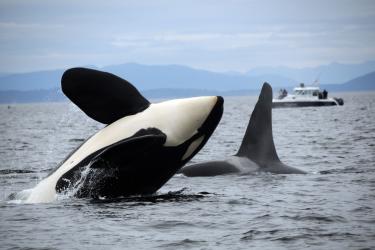A new NOAA technical memorandum (PDF, 44 pages) describes a statistical framework for modeling population changes in Chinook salmon in the Columbia and Snake Rivers. Known as an integrated population model, the framework provides a way for fish biologists, managers, and industry to make better-informed decisions about fisheries management by providing more accurate estimates of future populations and their risks of extinction.
Process vs. Observation
The framework is more comprehensive and accurate because it better accounts for error. Traditional models don’t explicitly distinguish between process and observation error.
Process error comes from the environment itself. For whatever reason, one year might be particularly good for salmon, another particularly bad. Good or bad years translate into large or small cohorts of offspring, respectively, and so can affect a population for generations to come.
Observation error, on the other hand, comes from our own human limitations. Since we can’t observe fish all the time, we have to pick a day to go out and look for them. If the majority of the fish happen to be up- or downstream from us when we get there, we might think there are fewer of them than there really are. Unlike process error, this type of observation error won’t affect the population’s future trajectory—the fish don’t care if we over- or undercount them.
In more traditional statistical models, these two errors are often conflated in a single estimated error term. This is not ideal, as Dr. Eric Buhle, an NWFSC ecologist and lead author of the new tech memo, explains: “One of the things that could happen is that you’ll overestimate the strength of density-dependence.”
Density-dependence means that the rate at which a population grows depends on how many individuals are living close together. In many cases, populations at relatively low densities tend to be more productive per individual, due in part to better availability of resources.
“This implies that as the population goes down, it compensates by increasing its productivity,” Buhle explains. “And obviously, when you’re down in the tank, how quickly you can climb back out is a really vital quantity to understand.”
This is why the new model is a better tool for management. “For both of these reasons—getting the errors right, and getting the strength of density-dependence right—I think people should be thinking about modeling frameworks like this one when questions of conservation or rebuilding come up,” says Buhle.
Accounting for Uncertainty
The new tech memo provides the model’s predictions in the form of intuitive probability distributions. “This lets you do all kinds of things,” Buhle notes. “In terms of harvest, you could make recommendations based on these results. You can use the tables and say, ‘Okay, if my harvest rate was this, what’s the population forecast 25 or 50 years from now?’
“This is a framework that lets you say, ‘There is an X% chance of event Y happening if I do Z’ (where doing Z is applying a particular harvest rate).”
To learn more about the model, and to see the predictions it makes, take a look at the new tech memo ({PDF, 44 pages), available now on the NWFSC website.



